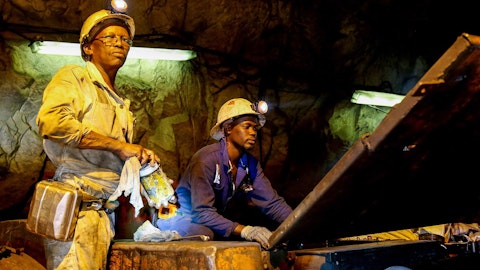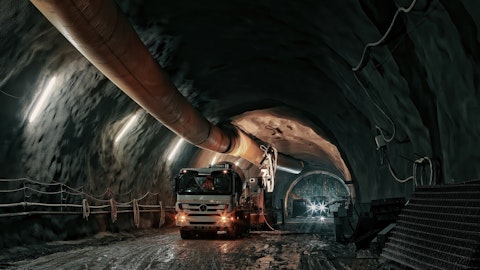Newmont Corporation (NYSE:NEM) Q2 2023 Earnings Call Transcript July 20, 2023
Newmont Corporation misses on earnings expectations. Reported EPS is $0.33 EPS, expectations were $0.44.
Operator: Good morning and welcome to Newmont’s Second Quarter 2023 Earnings Call. All participants will be in a listen-only mode. [Operator Instructions] Please note, this event is being recorded. I would now like to turn the conference over to Tom Palmer, President and Chief Executive Officer. Please go ahead.
Tom Palmer: Thank you, operator. Good morning, everyone, and thank you for joining Newmont’s second quarter earnings call. Today, I’m joined by my executive leadership team, including our Chief Operating Officer, Rob Atkinson, and we’ll all be available to answer your questions at the end of the call. I’d also like to introduce our recently appointed Chief Financial Officer, Karyn Ovelmen. Karyn is a highly experienced financial professional who has held both CFO roles and Board seats in the resource and energy sectors. She brings a breadth of global experience, and we are very pleased that she has joined the Newmont team. Before I begin, please note our cautionary statement and refer to our SEC filings, which can be found on our website.
Guided by a clear consistent strategy, our focus is on running a safe and sustainable mining business to generate long-term value. Our business is underpinned by a strong balance sheet and a global portfolio with the size and scale to make decisions that deliver on our strategy. And while I’m not happy with our ultimate financial results for the second quarter, I am very comfortable with the prudent decisions that we made during the quarter to safeguard our workforce, protect long-term value, and position Newmont to deliver strong performance in the second half of this year and beyond. During the second quarter, Newmont produced 1.2 million ounces of gold and 256,000 gold equivalent ounces from copper, silver, lead, and zinc, generating nearly $1 billion in adjusted EBITDA and more than $650 million in cash from our continuing operations.
There were four important decisions that we made during the second quarter. First, we decided to suspend operations at Peñasquito to focus on finding an appropriate and sustainable resolution to the current dispute with the Union representing our workforce in Mexico. This dispute is associated with a profit-sharing agreement that we made with the Union leadership only 12 months ago. And in May, we paid our employees their profit-sharing bonus for the 2022 year, calculated in strict accordance with this agreement. The Union leadership are now demanding more than double the agreed amount and have taken strike action through the withdrawal of labor. At Newmont, Peñasquito sits within a strong, balanced global portfolio of operations, a portfolio that is supported by the industry’s strongest balance sheet.
During this important time for Peñasquito, we will remain firm in our resolve and continue to make decisions that protect the long-term value of the operation and benefit our employees, our contracting partners, our host communities, our customers, and all of our stakeholders. We strongly encourage the Union leadership up to and including Senator Napoleón Gómez to cease this strike action and return their members to work. The second decision we made during the quarter was associated with protecting our workforce at Éléonore from the unprecedented wildfires being experienced this summer in Canada, evacuating the mine and placing the operation on care and maintenance. Third, at Cerro Negro, we made the decision to pause mining for two weeks and complete important safety inspections to ensure that we had the appropriate control environment in place at this remote underground mine and to protect the health and safety of our mining teams working there.
And finally, at Akyem, we made the decision to process lower grade stockpiles that were originally planned for the fourth quarter in order to optimize the mine plan, ensuring that we are in a position to safely extract the maximum amount of ore as we complete the current layback in the gen pit over the next few months. As planned, higher gold production is expected in the second half of the year, and will be driven by higher grades and tonnes mined from both Subika Underground and open pit at Ahafo. Higher grades and tonnes mined Cerro Negro is the first wave of our district expansion which comes online in the third quarter. Higher tonnes mined and processed at Tanami, where we will mine the highest grades for the year in the fourth quarter.
Higher grade run-of-mine ore processed at Akyem as we return and complete the current layback. And when combined with the higher production that we expect from our two non-managed joint ventures, Nevada Gold Mines and Pueblo Viejo, we remain on track to deliver on our full year guidance. We ended the quarter with $6.2 billion in total liquidity and maintained an investment-grade balance sheet, preserving financial flexibility as we continue through a period of meaningful reinvestment and return a stable dividend to our shareholders. Consistent with our 2023 dividend payout range, we declared a second quarter dividend of $0.40 per share, demonstrating both our ongoing commitment to shareholder returns and our confidence in the long-term strength of our business.
We remain on track to close on our acquisition of Newcrest in the fourth quarter and are leveraging the lessons we learned from the successful integration of Goldcorp four years ago as we build out our integration plans. We have also commenced the portfolio optimization work associated with this transaction, making the important decision in June to defer the Yanacocha Sulfides project. This is the first step in delivering significant value through portfolio optimization, and we will continue to evaluate opportunities to resequence project capital and rationalize the portfolio of the combined company over the next couple of years. At Newmont, we recognize that a strong, safety and sustainability culture is not only an indicator of a reliable well-run business.
It is fundamental to delivering on our commitments to employees, contracted partners, host communities and all of our stakeholders. As we position ourselves to safely integrate Newcrest and enter this next chapter in Newmont’s 102-year history, we made an important decision in the second quarter to further strengthen our commitment to responsible gold leadership and increase our focus on safety and sustainability. In June, we promoted Suzy Retallack for the role of Chief Safety and Sustainability Officer, reporting directly to me. Suzy is an industry leader with more than 20 years of experience in driving value-based decisions. Over the last five years, as our Senior Vice President, Health, Safety and Security, Suzy has been instrumental in leading the delivery of a step change in Newmont’s safety performance, in particular, in the area of fatality risk management.
Suzy will apply the lessons we have learned from our significant improvement in health, safety and security to further improve our performance in the areas of environment and social responsibility. In this new role, Suzy will also support me and my leadership team in the work we need to do as a company and as an industry to create workplaces that are free from harassment, assault, bullying and discrimination. I’ll now turn it over to Rob and then to Karyn to take us through each of our operations and projects, along with a review of our quarterly financial highlights. Over to you, Rob.
Rob Atkinson: Thank you, Tom, and good morning, everyone. Turning to the next slide, let’s begin in Australia. Boddington delivered another strong performance in the second quarter increasing both gold and copper production from sustained grades and improved mill throughput. As part of our multi-decade life of asset strategy for Boddington, we have increased our autonomous haulage fleet with five additional trucks as we increased the planned waste movement in both the North and the South pits. This investment into the next layback at Boddington will support stable gold and copper production for many years to come. We remain clearly on target to hit our 2023 production guidance, and we are well positioned to deliver more than 1 million gold equivalent ounces from this cornerstone asset.
Moving to Tanami, the site has recovered extremely well following the record wet weather and extensive flooding experienced in the Northern Territory during the first quarter. We doubled our quarterly gold production in the second quarter and remain firmly on track to land within our full year guidance ranges and will mine the year’s highest grades in the fourth quarter. In addition, we continue to progress the second expansion at Tanami with nearly 50% of the concrete lining of our 1.5 kilometer deep shaft installed. The lining and the furnishing of the shaft continue to be on the critical path as our project team works to deliver significant ounce and cost improvements to our Tier 1 operation in Tanami. Moving up to Africa. In June, I visited both the Ahafo South and Akyem as well as our Ahafo North project in Ghana.
At Akyem, I spent time with the team as we work through the decision Tom covered earlier to prioritize safety, optimize the mine plan and maximize the ore extracted as we close out the current layback in the coming months. As a consequence of this work, we expect grades to improve by 35% during the third quarter, positioning the site to deliver significantly higher production in the second half of the year and land within our 2023 guidance ranges. At Ahafo South, we delivered higher production as we access the third mining level and additional draw points in the Subika Underground ahead of plan. Fined with access to higher grades from the open pit, the Ahafo mill will process higher grade from both underground and surface in the second half.
Ahafo is also on track to commission a replacement conveyor in the third quarter and it remains on target to hit guidance for the year. And finally, it was great to see firsthand the progress we are making on the Ahafo North project. The highway relocation in bulk airports continue to progress very well and with the new mining fleet in place, the project team is preparing to commence pre-stripping in the second half of the year. Moving across to North America. As Tom described, Canada has been impacted by unprecedented wildfires, with Quebec, particularly impacted during the second quarter. And in the second week of June, as the fire front approach the property, we made the swift and proactive decision to evacuate our workforce and place Éléonore on care and maintenance to protect our employees and contractors.
During this time, our first priority was, and will always be, the safety and well-being of our workforce and local communities. We’re now safely ramping up production activities as the forest fire threat continues to abate. And we will continue to monitor the situation in Quebec very closely as we work with the provincial government agencies to assess fire progress and air quality on a daily basis. Moving to Porcupine, we delivered another steady performance in the second quarter and remain well-positioned to deliver improved production in the second half of the year driven by higher grades from the Hollinger pit in Q3 and from Borden Underground in Q4. We continue to progress the Pamour project and are preparing for a full funds investment decision later this year.
We will complete commissioning of a new water treatment plant in the coming weeks, which will accelerate dewatering of the premarket and allow us to commence pre-stripping during the fourth quarter with first ore expected in 2024. At Musselwhite, we delivered consistent gold production as we progress planned development activities that will increase scope availability in the second half of the year, including access to another double lift stope [ph]. As a consequence, we expect tonnes mined to increase by more than 30% and grades to increase by around 15%, supporting a strong third and fourth quarter. And finally, Cripple Creek and Victor delivered solid results due to higher grade and strong recoveries from our heap leach facilities. And now moving down to South America.
Yanacocha delivered a strong second quarter as we begin to realize the benefits from applying our injection leaching technology. At Merian, we continued the planned stripping of the next layback in the Merian Pit and the site is on track to deliver 40% higher grade from the Maraba pit in the third quarter, putting Merian on target to hit full year guidance. Moving to Cerro Negro. In the third quarter, tonnes mined is expected to increase nearly 30% as the underground ramps up to full productivity following the safety pause that Tom referred to, and grade is expected to increase by 50% as we begin to access the higher-grade stopes from San Marcos, the first of six new deposits associated with the exciting underground district expansion at Cerro Negro.
San Marcos will continue to ramp up throughout the year and is expected to reach commercial production in late 2023. Finally, as Tom discussed, we made the decision to suspend operations at Peñasquito on June 7, as we focus on finding a resolution to the dispute with the union leadership. We have and will continue to abide by the fair and equitable agreement that is currently in place and that was importantly, fully agreed to only a year ago with the union. We will continue to communicate directly with our employees and engage with the union leaders and government officials to find a fair, appropriate and sustainable resolution to this very disappointing dispute. You can expect that we will provide a fulsome update to the market once an agreement has been reached, and we look forward to returning our focus to safe and sustainable mining at Peñasquito.
And now I’ll wrap up on the next slide with our two non-managed joint ventures. Our share in Nevada Gold Mines and interest in Pueblo Viejo contributed 338,000 ounces of attributable gold production in the second quarter, and we look forward to both joint ventures delivering on their expected strong second half. And with that, I’ll pass it over to Karyn to cover our financial results.
Karyn Ovelmen: Thank you, Rob, and good morning, everyone. I’m happy to be joining the call today and look forward to presenting our second quarter financial results and answering any questions you might have. Before I get started, I wanted to talk briefly about what brought me to Newmont. When I was doing my due diligence on Newmont, I was excited to learn about the company’s clear and consistent strategy, leading approach to safety and sustainability, its global diverse portfolio of assets and deep project pipeline to position Newmont for long-term success. Joining in May, I’ve had the pleasure to meet Newmont’s senior leaders and the Board and spend time with my very talented finance team. And I can say that the strength of our people and capabilities have already far surpassed our initial expectations.
Over the coming months, my team and I will be focused on building upon the strong foundation that we have today, partnering with the business to improve our overall financial performance and driving our disciplined capital allocation strategy, with a balance sheet that can support our strategic initiatives throughout the commodity cycle. Turning to the next slide. Let’s get started with a look at the financial highlights. In the second quarter, Newmont delivered $2.7 billion in revenue at a realized gold price of $1,965 per ounce, adjusted EBITDA of $910 million, cash from operations of $656 million, which includes over $100 million of unfavorable working capital changes. Included in working capital changes were nearly $250 million in tax payments in the second quarter, partially offset by a draw on receivables.
We would expect to draw on receivables to reverse in future quarters. The tax payments to decrease in the third and fourth quarter as they have in previous years. In total, we generated $40 million of free cash flow for the quarter, which is net of more than $600 million of capital spend as we continue to progress our most profitable near-term projects and position the portfolio for growth, both in ounces and margins in future years. We maintained a strong cash position with $3.2 billion and an attractive leverage ratio of 0.7 times net debt to adjusted EBITDA. We also maintained solid margins in the second quarter, driven by higher realized gold prices and steady direct costs. Second quarter GAAP net income from continuing operations was $155 million, or $0.19 per diluted share.
Adjustments included $0.05 related to unrealized mark-to-market losses on equity investments, $0.03 related to transaction cost associated with our pending acquisition of Newcrest, and $0.06 related to tax adjustments and other items. Taking these into account, we reported second quarter adjusted net income of $0.33 per diluted share. And it is also important to note that this number has not been adjusted for the $46 million in operating costs and depreciation at Peñasquito since the strike commenced and at Éléonore, while the site was proactively shut down due to the wildfires. As Tom and Rob noted, Newmont remains well-positioned to deliver a strong performance in the second half of the year and achieve our full year guidance. Second quarter, we declared a dividend of $0.40 per share or $1.60 per share on an annualized basis, consistent with the last two quarters and calibrated within our 2023 dividend payout range of $1.40 to $1.80 per share.
We have now maintained a dividend yield above 3% for 11 consecutive quarters, and this continues to be the highest dividend per share in the gold sector. With that, I’ll turn it over to Tom for an update on the time line from today through to the close of our acquisition of Newcrest.
Tom Palmer: Thanks, Karyn. Over the last two months since we announced the binding agreement to acquire Newcrest, my team and I have engaged with many of our important stakeholders, including employees, shareholders, local communities and government leaders. These conversations were aimed at listening to and answering questions, whilst also ensuring that the benefits of the transaction and Newmont’s strategic rationale were well understood. Over the next couple of months, we will continue to progress the various regulatory approvals ahead of closing the transaction, primarily in Australia and Papua New Guinea. And I’m pleased to advise we’ve already received clearance from the Canadian government. Earlier this month, I visited Papua New Guinea for the second time, meeting with various government officials including Prime Minister, James Marape; Deputy Prime Minister, John Russo; and Mining Minister, Sir Ano Pala.
As we continue this engagement, we remain excited for the opportunity to operate Lihir, and develop the world-class Waihi gold boom project. We are diligently working towards launching a scheme booklet and filing a proxy statement this quarter with shareholder votes expected in October. We then expect to close the transaction in November and begin the important work to safely integrate the Newcrest teams and operations into our portfolio. Then be in a position to provide 2024 guidance for the combined company in February of next year, along with our fourth quarter and 2023 results. With that, I’ll thank you for your time today and turn it over to the operator to open the line for questions.
See also 13 Best Consulting Stocks to Buy Now and 10 Best Socially Responsible Stocks to Buy.
Q&A Session
Follow Newmont Corp (NYSE:NEM)
Follow Newmont Corp (NYSE:NEM)
Greg Barnes: Yeah. Thank you very much. Tom, I just wanted to ask about inflationary pressures and how you see them evolving into the second half of 2023 and 2024 ex any volume improvements you’re going to get, which obviously will help on a gold per ounce basis?
Tom Palmer: Yes. Thanks, Greg. Good morning. What we’re seeing in our direct cost is largely consistent with what we expected as we guided this year, and I just step through that in a little bit more detail. About half our cost base is labor, about 50% is labor made up pretty evenly between employees and contractors. Employees largely stable and expect that to remain largely stable through the rest of this year and into next. Certainly, seeing some settling down in Australia, Canada, United States. Contracted services also have stabilized. So still at a higher cost that we saw with the inflation coming through last year, but largely stabilized, maybe a little bit of easing into the second half of this year, but certainly seeing the volatility come out of that, and that’s at 50%, that’s a pretty important driver.
30% materials and consumables. So it’s the various reagents, particularly cyanide, explosive, steel for grinding media and the like. We’re seeing those largely consistent with what we expected. Natural gas prices have come off, which is then flowing through to the prices that we’re seeing for both cyanide and explosives. So a little bit of relief tailwinds with those consumables and would expect that to flow through the second half of this year. We’ll see supply of natural gas may be tighten a bit, which may put a bit more tension on those prices, but certainly expecting to see that stable or a little bit of an improvement and still pretty much holding its own as we look at the grinding median to remove around the place. And then the next big category is fuel and energy 15% and that’s driven by diesel.
And we’ve certainly seen some relief in oil prices relative to what we’ve assumed. And we would expect to see that carry on through the second half of this year, but a volatile commodity and one that we’ll continue to be conservative as we think about our assumptions for that. So a few tailwinds reg some stability and consistent with what we expected for 2023.
Greg Barnes: Great. That’s very helpful, Tom. And just a follow-on. In the presentation, you talked about the guidance you’re going to provide in February. I’m just wondering how detailed do you expect to be in February around Newcrest and your expectations for how that’s going to fold into the company in 2024?
Tom Palmer: We’re certainly working towards being in a position where we can give you a view of 2024 for the combined portfolio, which would include our view of the five Newcrest assets being folded into our operations. So if things continue to go to plan in terms of regulatory approvals, shareholder votes and close, integration planning busily being done. We’ll receive the keys to the car so to speak in early November, I would hope, and that gives us time to work through those mine plans, apply the Newmont lens on those mine plans and the assumptions we make for some of the key input assumptions and certainly working towards being in a position to provide the 2024 guidance for the combined portfolio in the February timeframe.
Greg Barnes: And what about the three to five-year guidance beyond that, will that wait?
Tom Palmer: We will monitor that. And see how those numbers come together. We’ll certainly be looking in the 2024 timeframe to provide as much information as we think appropriate, certainly for 2024 in that February timeframe and then — and look for a logical time for a Capital Markets Day to share some more information on the combined portfolio and maybe even look to try and include some sort of site visit with that. So, that’s still work in progress, Greg. But certainly, 2024 is in our side for the February timeframe.






